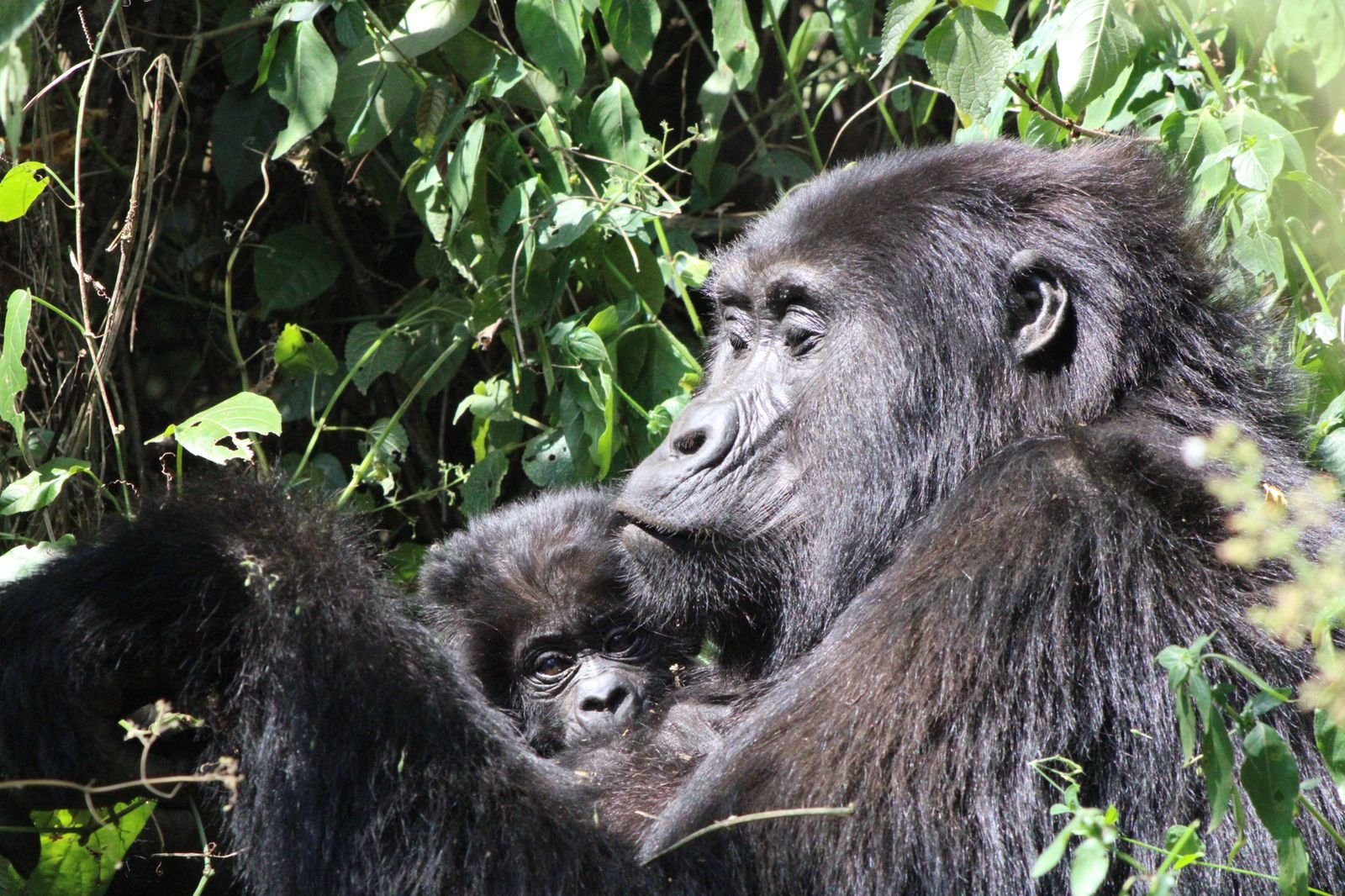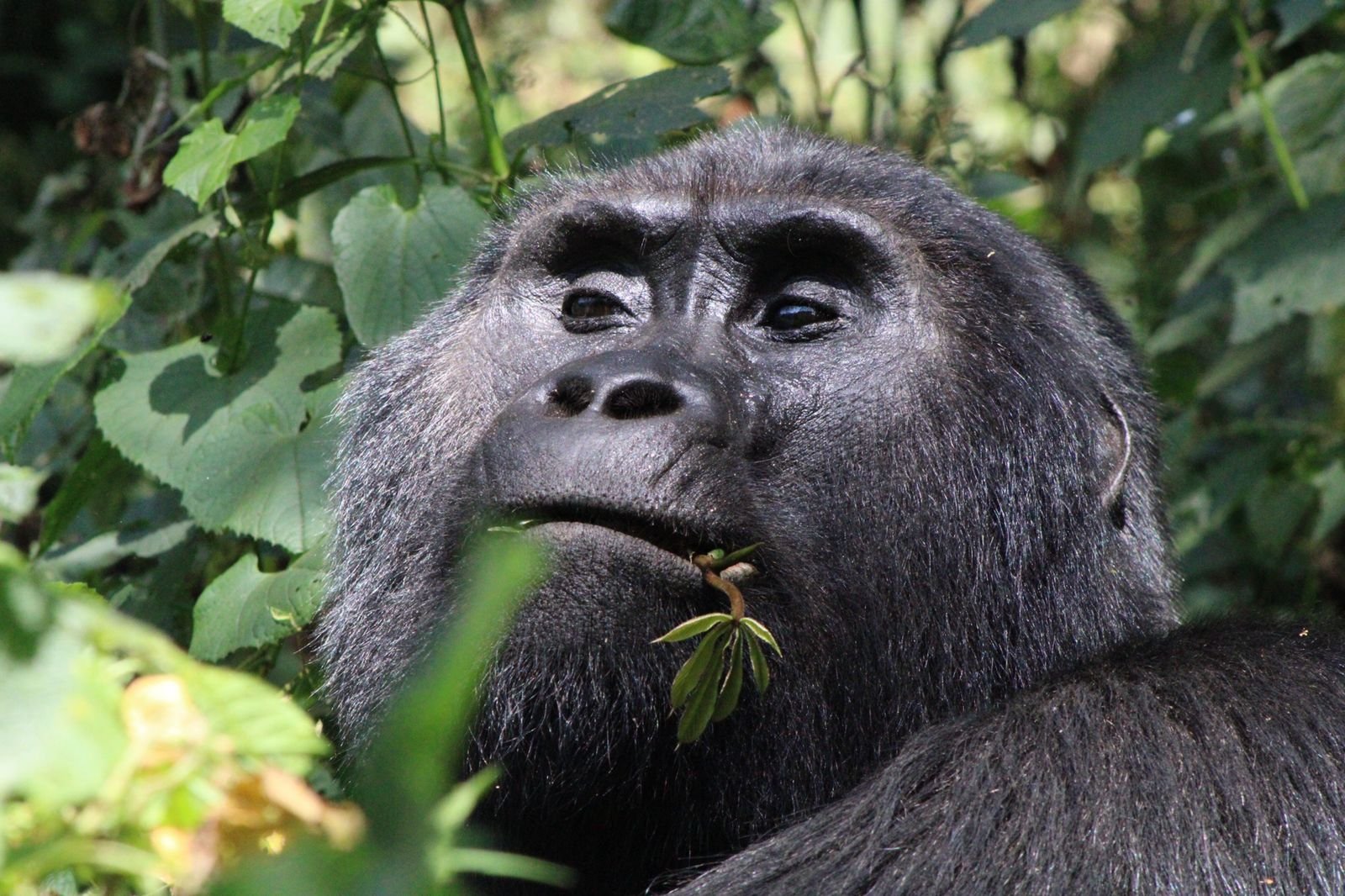Welcome to Travel + Explore & Play with Sallee Jay, I am your host, and I am so glad that you are here with me. I am so EXCITED for this blog!! It took me a while to gather my thoughts and for everyone who has been following along with my African adventures, thank you all for your patience! This is going to be another long blog, as I have so much information to share with you all.
In fact, sitting down to write this gives me chills and brings tears to my eyes at the same time.
YALL, I was in Bwindi National Forest watching real life interactions of gorillas in their natural habitat!!!
I am still amazed at how this experience all came together. Since returning home, I have really struggled to capture the essence of my gorilla trekking experience. It is important to me to tell my story as well as the story of the apes, as sustainable ecosystems of the future will depend on us educating more people about how much is at stake. I’m excited to share stories about my fellow trekkers, our experience with an “African helicopter’ rescue and the nature of the hike itself. However, when I reflect on the hour spent with the Xmas gorilla family, I am left both humbled and speechless by nature and creation.
I know you may be thinking…..
WHY GORILLA TREKKING???
〰️
WHY GORILLA TREKKING??? 〰️
For those who know me intimately this adventure comes as no surprise, I love the great outdoors, wildlife and have a soft spot for conservation. I have always been naturally curious and dare to be different in my approach to bringing awareness to the various conservation endeavors that are needed in order to sustain our planet and push humanity forward. I am one of those people crazy enough to believe, that I can make an impact in the lives and communities that I serve.
Professionally, I work for the local water utility and have 20 years of experience working for engineering/consulting firms and organizations that support water/wastewater treatment. Ecosystems and water systems are extremely important to me, which by default makes biodiversity a point of interest for me as well. Environmental justice is also a growing passion of mine. Therefore, i am always open to opportunities to go out into the field to observe the impacts and adjustments that are needed in order to maintain society and begin to structure more equitable outcomes for people and the planet. Lastly, as a finance professional, I want to be on the forefront of the profit, people and plant equitable finance solutions. That is my long answer for why I went gorilla trekking, in addition to my love for exploring Africa — it truly is one of the most beautiful places on earth.
Confessions of a Travel Blogger:
Gorilla Trekking is serious business!! This is NOT an activity to get a shot for the “gram!,” your goals should be much greater! While I am sure that adrenaline junkies all over the world have been drawn to go down this path — gorilla trekking is for individuals who embrace and value nature. Gorilla trekking is for the conservationist, naturalist and animal lover at heart. It’s an opportunity to see an endangered species while trying to understand the very complex issues surrounding the decline of this GREAT APE and the beautiful resources of Africa.
Now that we have all of that out of the way, on to the gorillas!
GORILLA FACTS:
There are two species of gorillas – The Eastern Gorilla and the Western Gorilla and they have two sub species. Mountain gorillas in Uganda are found in two national parks, Bwindi Impenetrable Forest National Park and Mgahinga Gorilla National Park. Based on the recent census of mountain gorillas, the total number of gorillas is now 1,063 across the countries of Uganda, Rwanda, and Congo. This is great news as the numbers of these great apes are increasing, however, the International Union for Conservation of Nature (IUCN) classifies the Gorilla beringei species (mountain gorillas and Eastern lowland gorillas) as endangered on its Red List of Threatened Species. They are hunted and their habitat has been destroyed by mining and agriculture cultivation. IUCN estimates that there are about 680 mountain gorillas left in two isolated populations. While data to support this is lacking to determine the population of Eastern lowland gorillas, the IUCN says it is believed that the total population has decreased dramatically.
The mountain gorilla lives in the mountainous regions of central Africa, while the lowland gorilla lives in the flat, dense forests of central and western Africa. Though the two types are very similar, they have a few differences. For example, mountain gorillas tend to have longer hair, whereas lowland gorillas have short, soft hair, according to the Smithsonian.
According to the IUCN, the Gorilla gorilla species (Western lowland gorillas and Cross River gorillas) is critically endangered, with a population reduction of more than 80% over three generations (a generation is around 22 years). It is unknown exactly how many of these gorillas are left. The WWF estimates that there are about 100,000 lowland gorillas still in existence.
In Uganda, Mountain Gorilla conservation and habituation began in the early 90’s when Bwindi was declared a national park in 1991. Gorilla habituation is a more recent experience offered to mountain gorilla lovers, in which 4 tourists have the opportunity to partake in the process involved in the daily gorilla habituation preparation process. Under the guidance of researchers and trained trekkers, those who participate in the gorilla habituation experience get to spend 4 hours with the gorillas, with opportunities to observe: feedings, playing, family dynamics, climbing and so much more. There are two habituation families in Bwindi that you can visit with at the moment and this permit is slightly more expensive than the trekking permit.
Uganda has 18 habituated gorilla families in Bwindi and each family can be visited by 8 tourist per day, bringing the permit count to 24 per day. The gorillas can be accessed from one of four sectors or access points in Bwindi. The four sectors are: Ruhijja Sector, Rushagga Sector, Buhoma Sector and the Nkuringo Sector. Mgahinga Gorilla Park only has one habituated family.
THE CHECK-IN:
With trekking rangers in search of gorillas in the area
Our trek starting point was the in Nkuringo Sector. The Nkuringo Sector is in the southern part of Bwindi and is the only sector with twin gorillas, born in 2004. It boasts incredible views of the Virunga Volcano Range and a number of crater lakes in the area. This entry point is recommended for visitors that are physically fit, highly determined, interested in adventure and prefer longer hours of trekking. I was told our trek lasted 2.5 hours longer that the other two groups that left at the same time.
That said, our trek began walking from headquarters, we walked through a village, a tea farm and then entered the forest for our moderately short hike to see the Gorillas (more about that later) — the other trekkers were driven to their sector entry point from my understanding and then trekked in to Bwindi see their respective families.
There are three habituated mountain gorilla groups within the Nkuringo sector for trekking visitation:
The Nkuringo family— this was the first habituated gorilla family in the area back in 1997, hence the origin of its name “Nkuringo sector”. It has about 19 members that were once led by Nkuringo silverback gorilla before it died in 2008. Bahati is the mature silverback gorilla that now controls the family. It contains 3 juvenile young gorillas, 2 silver-backs, 2 adult females, 2 sub-adults and 1 black back which are calm and so welcoming when they meet with human beings.
The Bushaho gorilla family— this is the second group to be habituated in the sector and has about 8-10 individuals led by Bahati, an adult silverback which originated from the Nkuringo family. It separated to form its own group that was habituated, and now the family is open for gorilla tourism throughout the year.
The Christmas gorilla family— The newest family in the sector is composed of 9 individuals which are led by a silverback gorilla called “Christmas” and has been recently opened for gorilla tourism. The name Christmas was given to silverback gorilla due to the fact that it was born on Christmas day.
THE TREK:
We met at the gorilla trekking headquarters at around 7:30am, to meet with our guides and representatives from the Uganda Wildlife Authority. We were entertained by a group of local dancers, from the nearby village before being broken out into our trekking groups for the day. I was told that I would be observing the XMAS family and joined the rest of my trekking crew. Once we were in our groups, we were given safety briefing, walking sticks and we headed out around 8am.
Local dancers providing entertainment before trekking.
I opted to hire a porter, which is someone who carries your belongings and helps you with the trek along the way. I HIGHLY RECOMMEND hiring a porter while trekking, Jeffrey, was the name of my porter and he certainly pulled me up the last few hills… your girl was HOT, TIRED and my calf muscles were on FIRE!!! They are affordable to hire and accept cash and tips!
Support the local community
I highly recommend hiring a porter for your trek. They are extremely helpful with keeping you encouraged and lending a helping hand along the way. This is in addition to toting your personal belongs for you.
Jeffery was my porter, and I could not have been more delighted to have him, especially in the home stretch. He basically dragged me very nicely, up the last hill. The other advantage of hiring a porter is that they know the route and can help set the pace of the trek! Behind 7-year-old Alice, was Jeffery and I to the final finish. He was a GOD send.
My group consisted of a family of three from Peru. A mother, her daughter 7-year-old Alice (a trooper for real) and her Papa. A couple from Mexico which included Ana Diaz, who is responsible for all of the up-close photos from our trek — she was about that action when it came to getting the shots. A married couple based out of the UK, however, the husband was from South Africa and me. At first glance, I was worried about the family from Peru, they did not seem to be dressed appropriately for the occasion and Papa did not see to be in the best heath. I prayed for the best knowing that we had all come a long way to partake in this extraordinary experience together, I had no clue what the day would actually have in store.
XMAS Gorilla Trekkers - Nkuringo Sector, July 2022
At the beginning of the trek!
We headed out with two armed officers, a guide and ranger. They send other rangers a head of the group to find the gorillas and send word back regarding the location. The trek to the gorillas was not too bad. We went through a village and there were a lot of switch backs that were low grade, sloping downhill. We kept a decent pace, I would say we trekked for about an hour and a half, before reaching the end of the village and meeting more rangers at the edge of the tea plantation. They informed us that we were about 5-10 minutes away from the gorillas. From there we had to maneuver through the tea plantation, that was difficult because of the grade and the narrowness of the trail. Poor Alice had to be placed on the shoulders of one of the rangers as she was not quite tall enough and was getting hit in the face with branches and tea leaves.
At the end of the planation’s edge, was the forest and you could feel the difference instantly. It was slightly cooler with all of the tree coverage overhead and the bugs were very real. At this point we were within minutes from interacting with real live gorillas. They informed us that XMAS was up a head eating. We all marched forward with eagerness and anticipation of what was coming. “THERE HE IS!” our guide calmly pointed out.
XMAS was sitting in the midst of the foliage, unbothered by our visitation as he continued to eat this breakfast. The ranger explained to us his origins and how he came to be the head of the family, his eating habits and his physique. And then he just got up and disappeared into the forest. It was at this point that things began to change. The first bit of excitement outside of the gorillas was when Papa exclaimed, “I need an African helicopter to get back!” The rangers made sure that he was good and began to radio for help. During our safety briefing, we were informed that if we were unable to complete the trek at any point this option was available to us for a fee between $300-$500 USD… More on Papa later, BACK TO THE GORILLAS!!
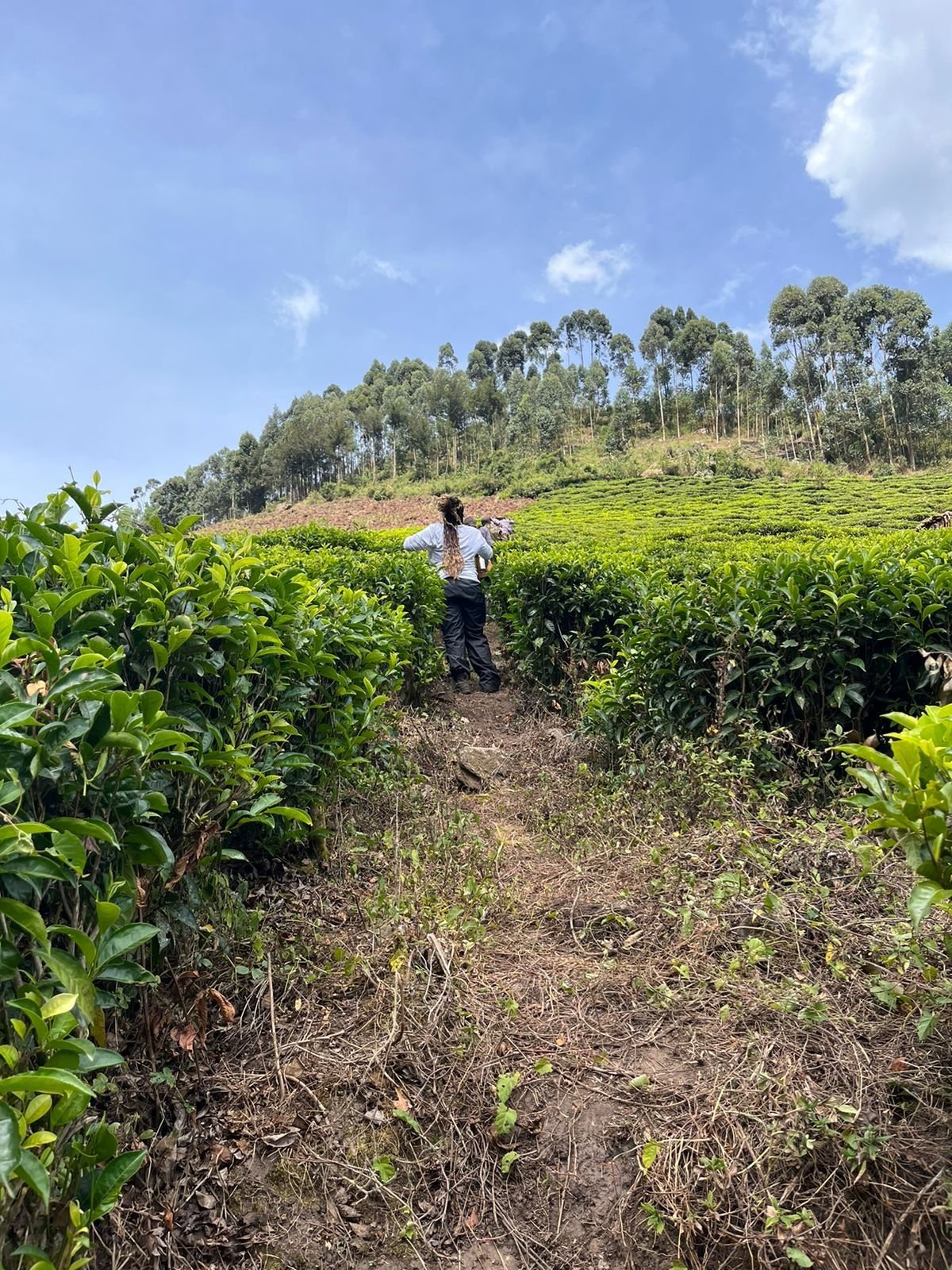
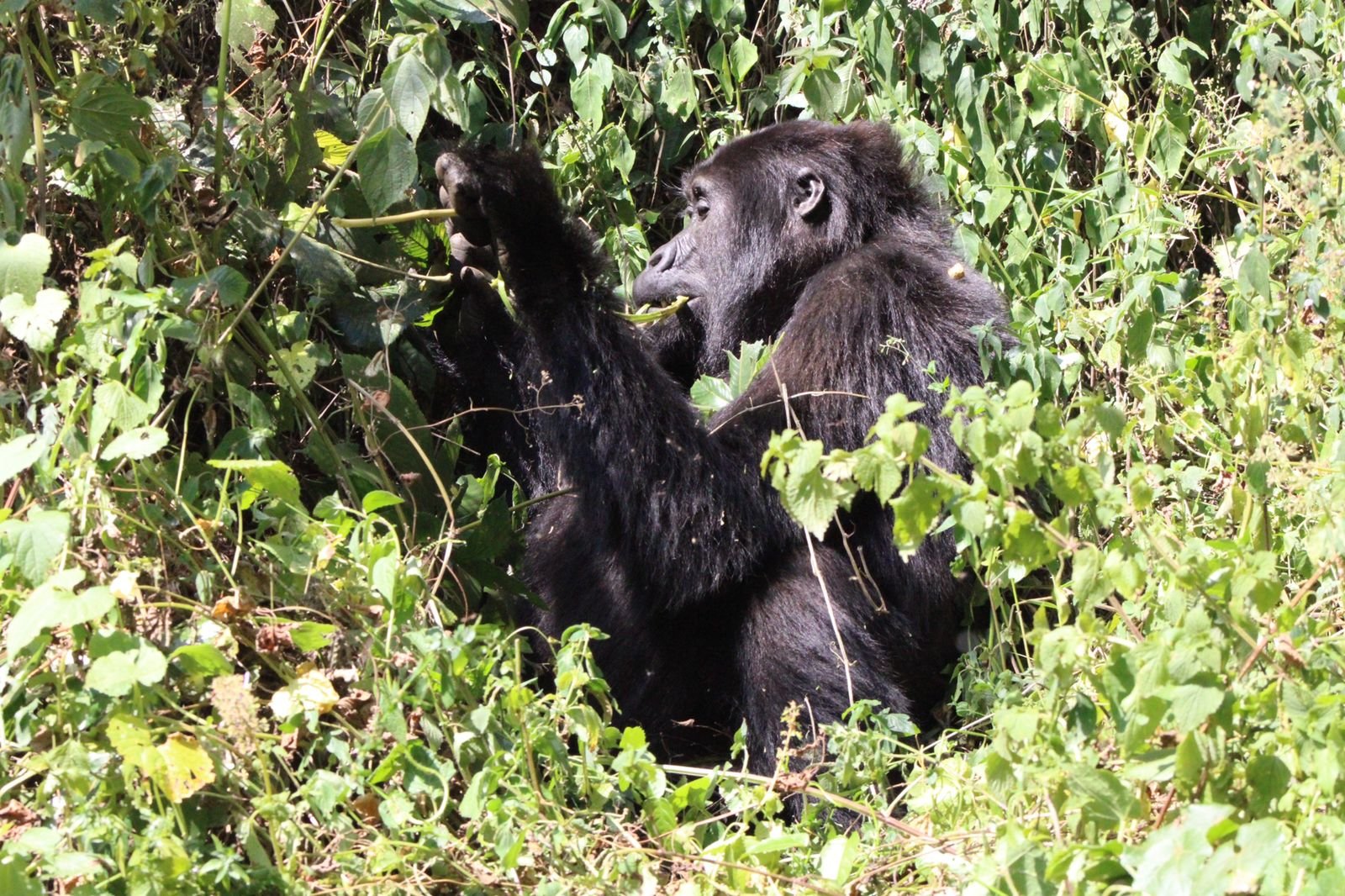
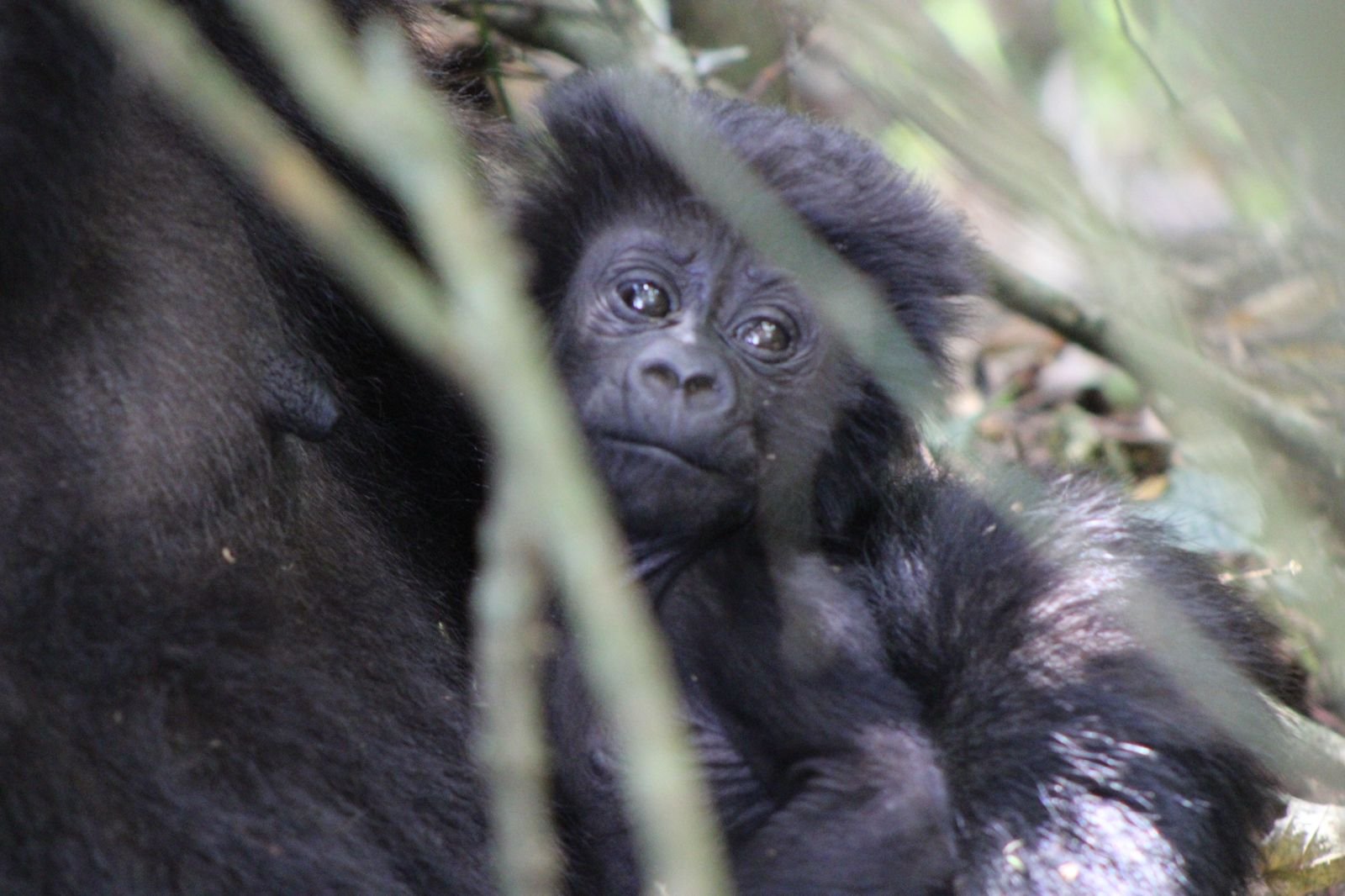
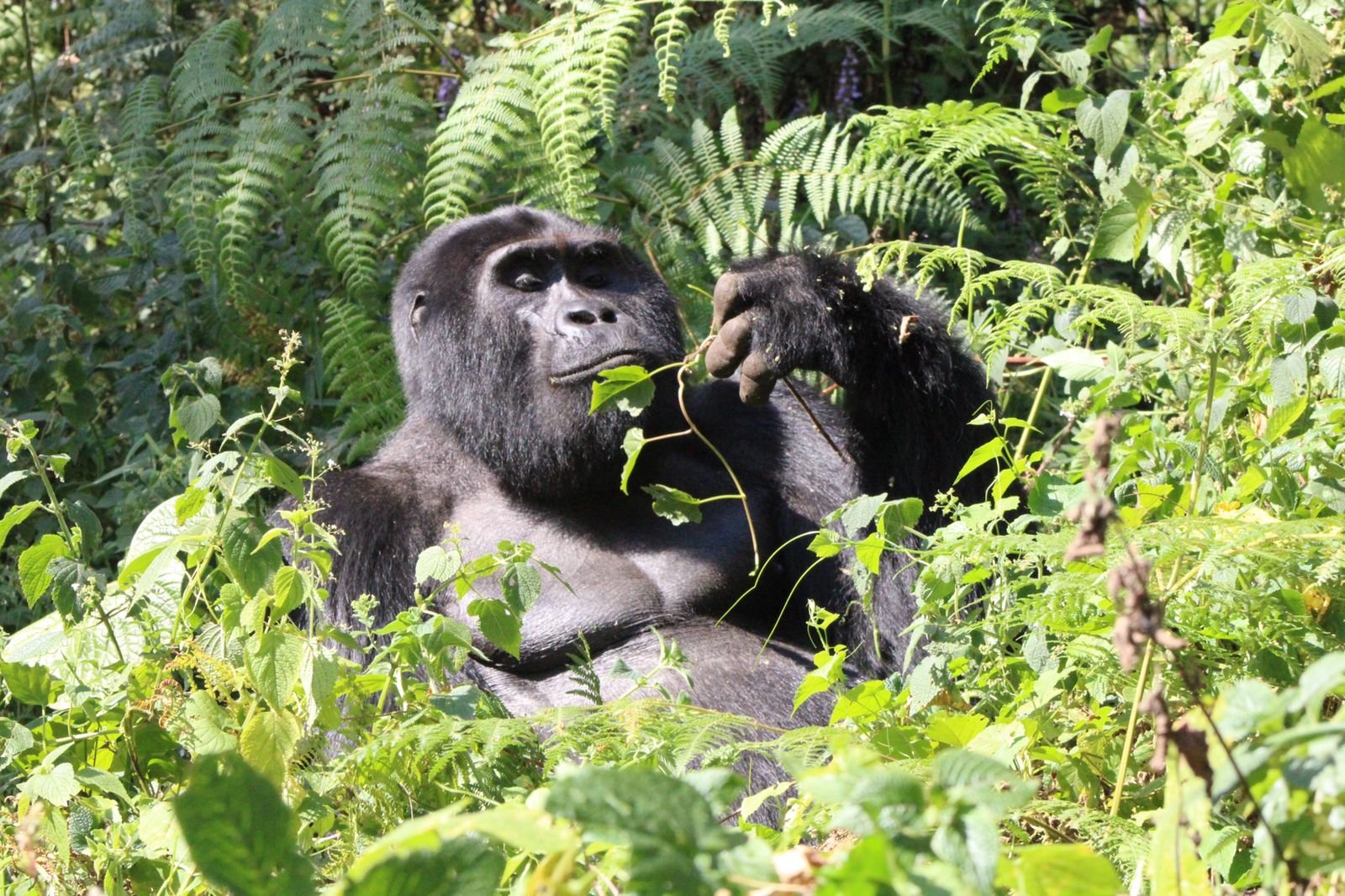
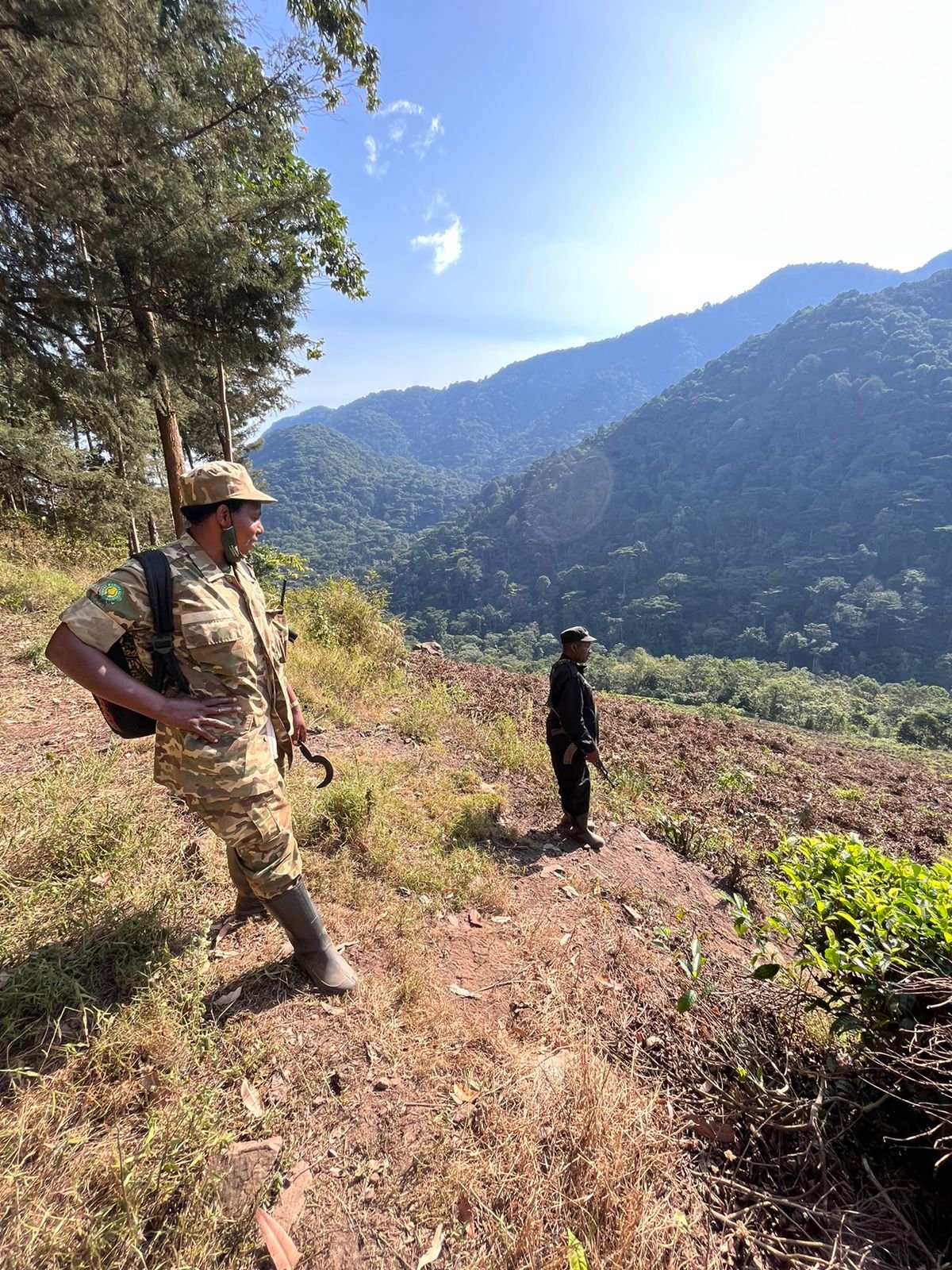
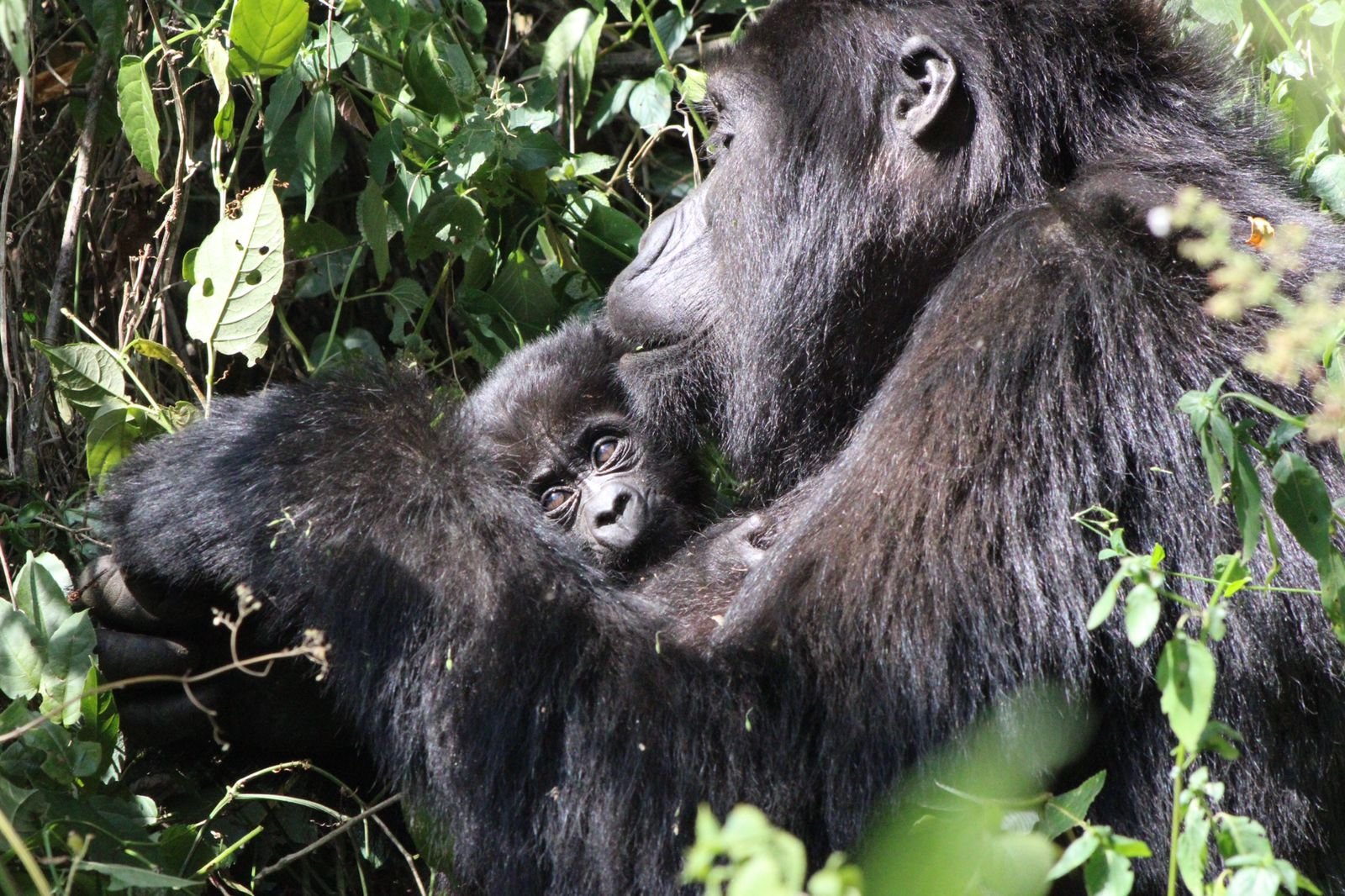
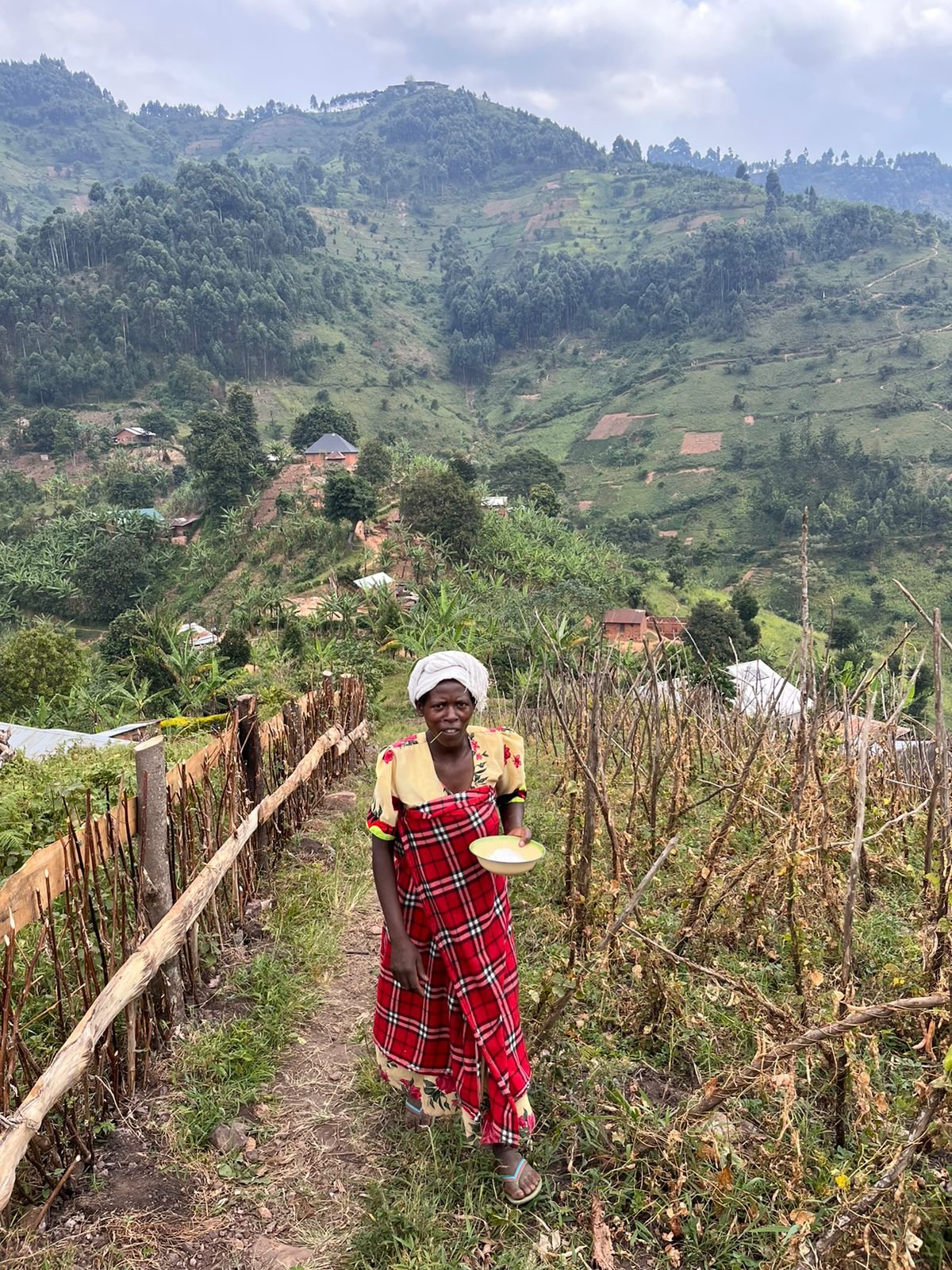
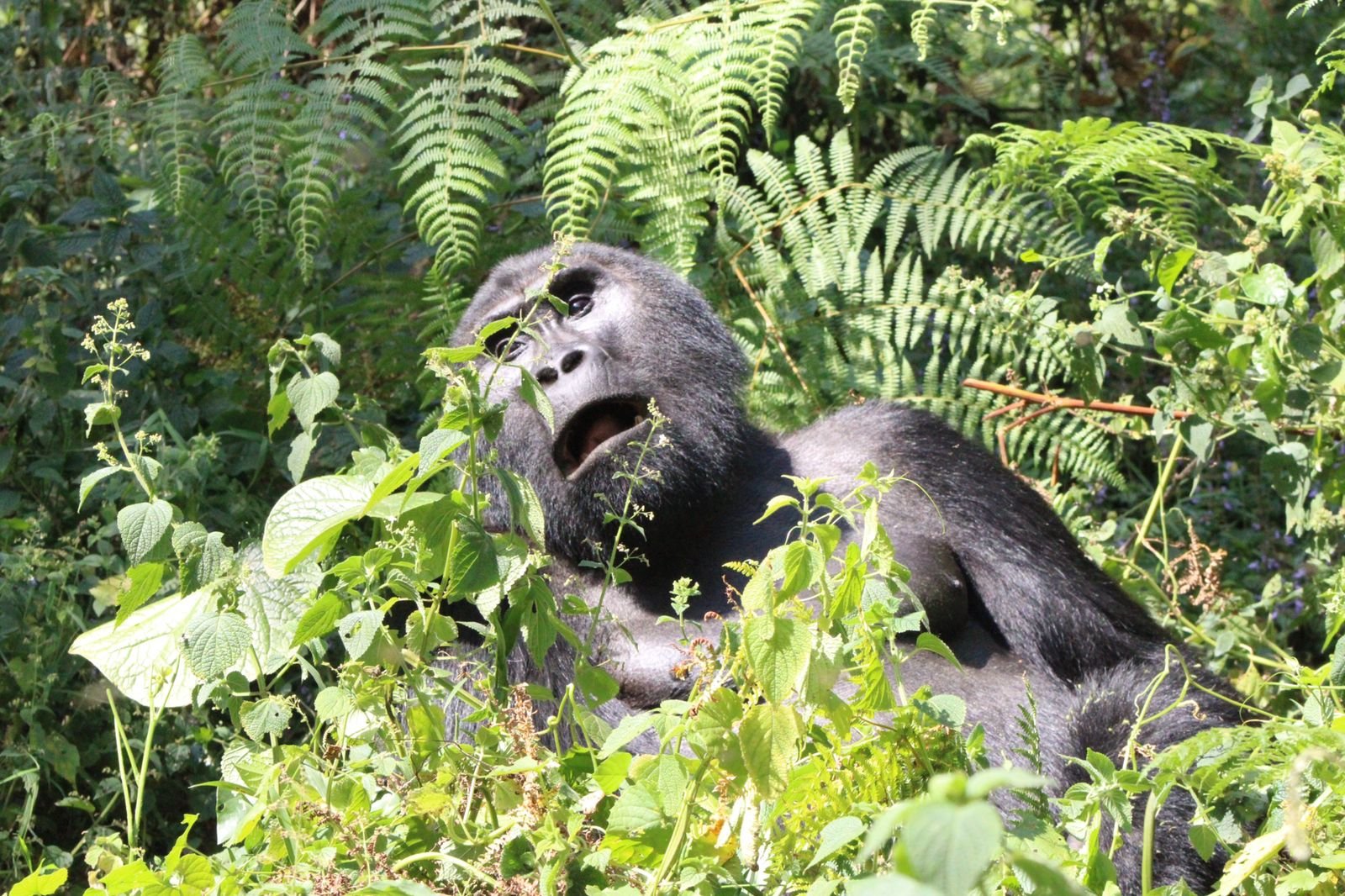
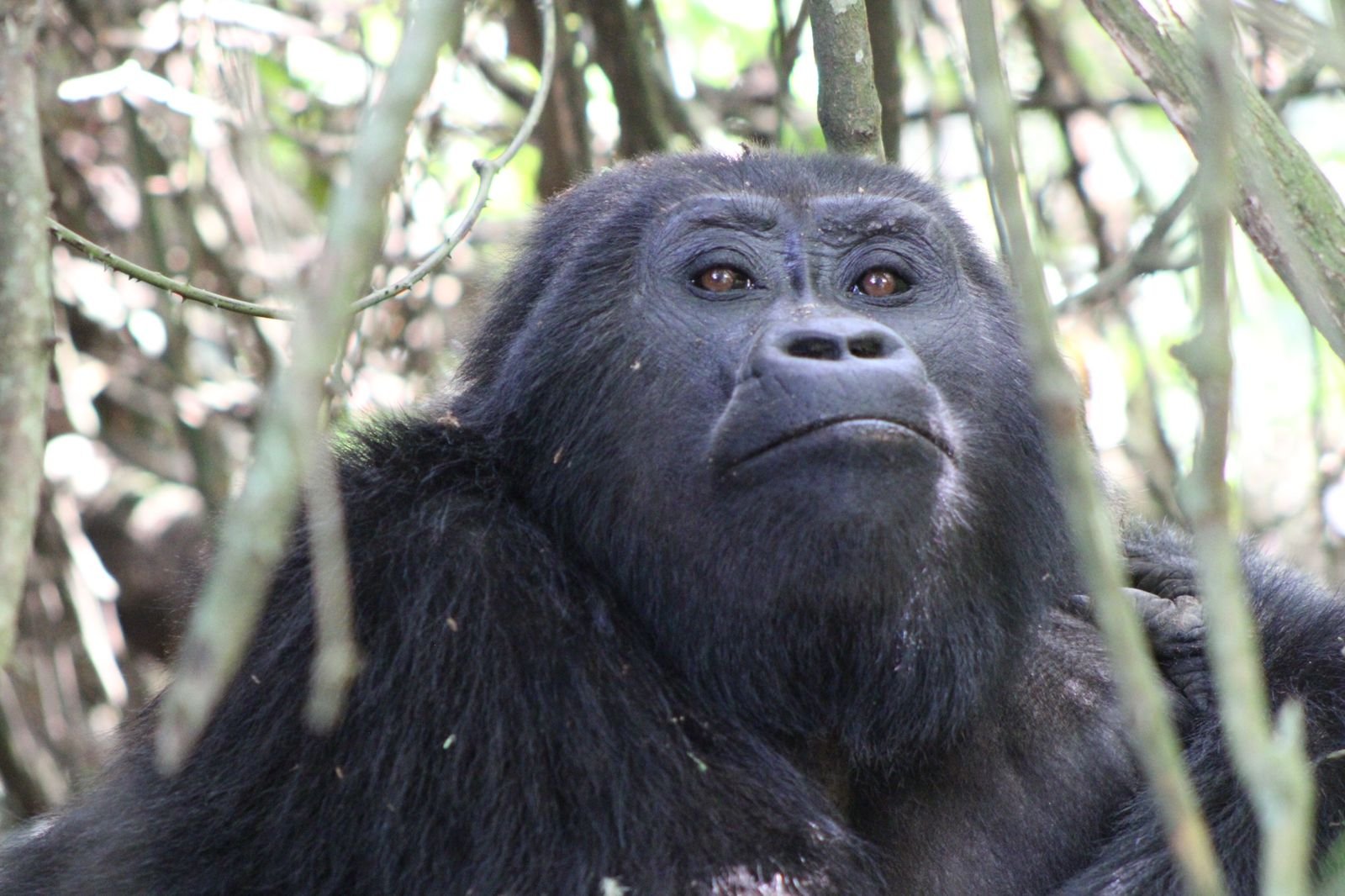
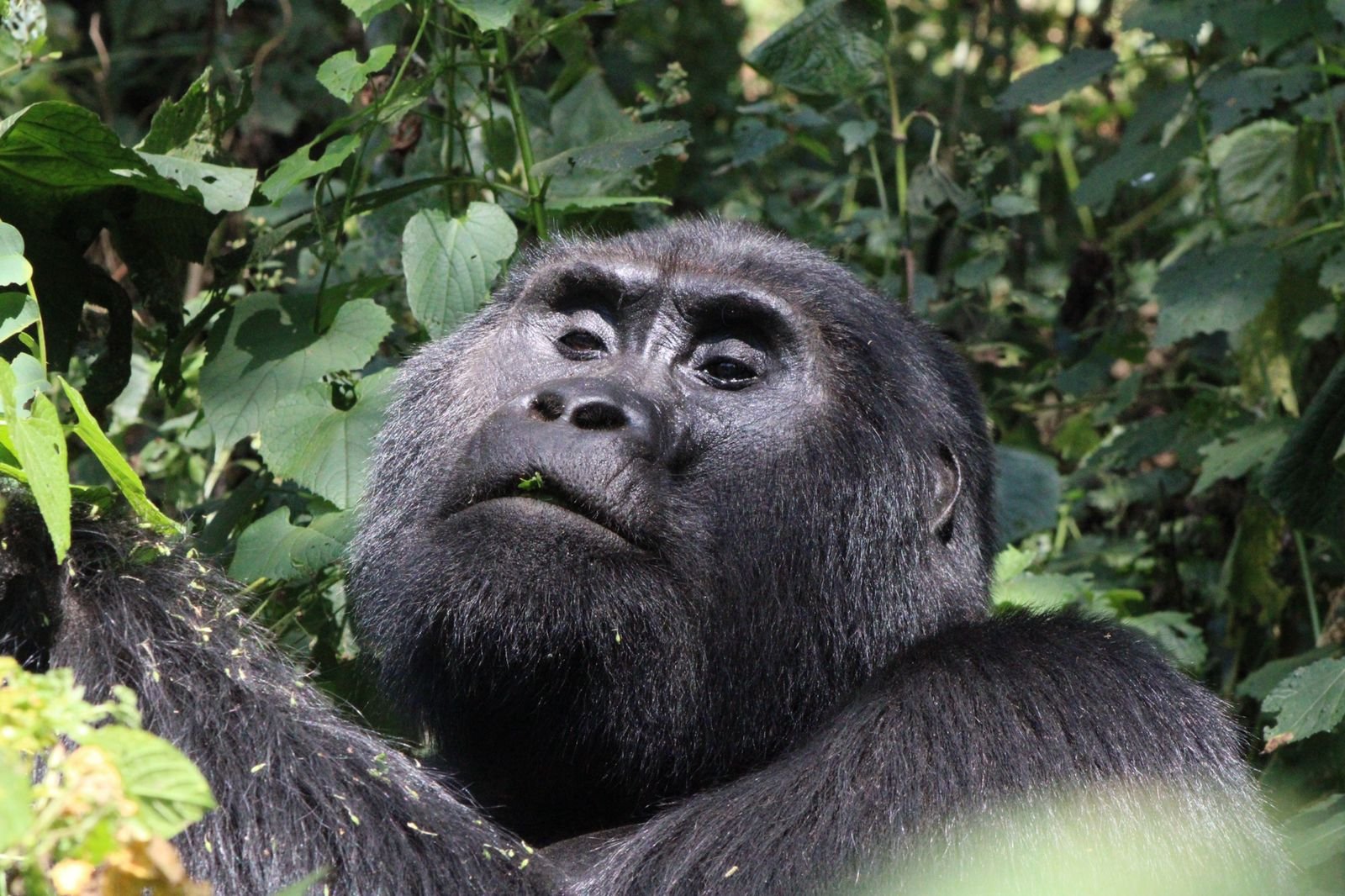
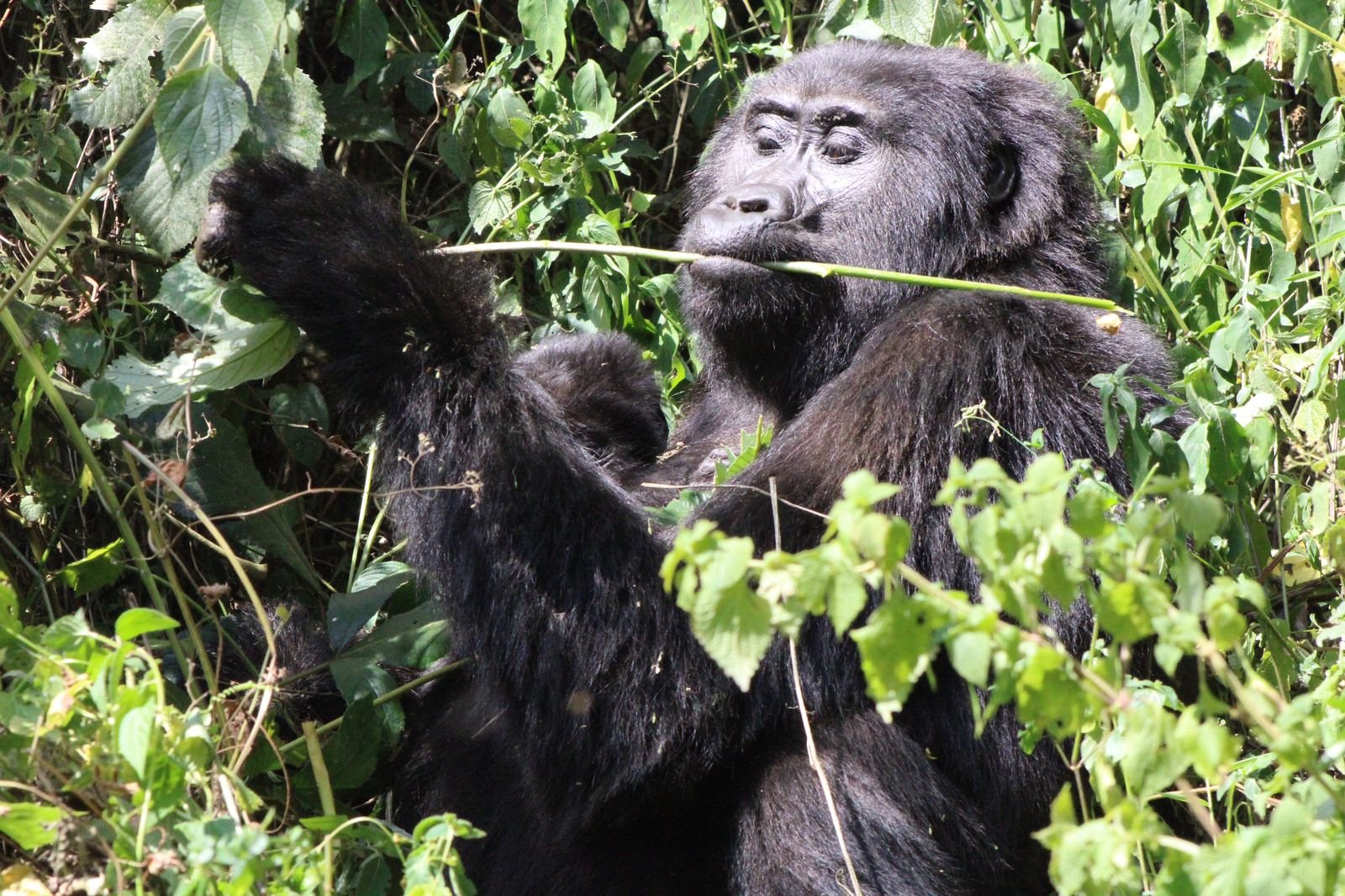
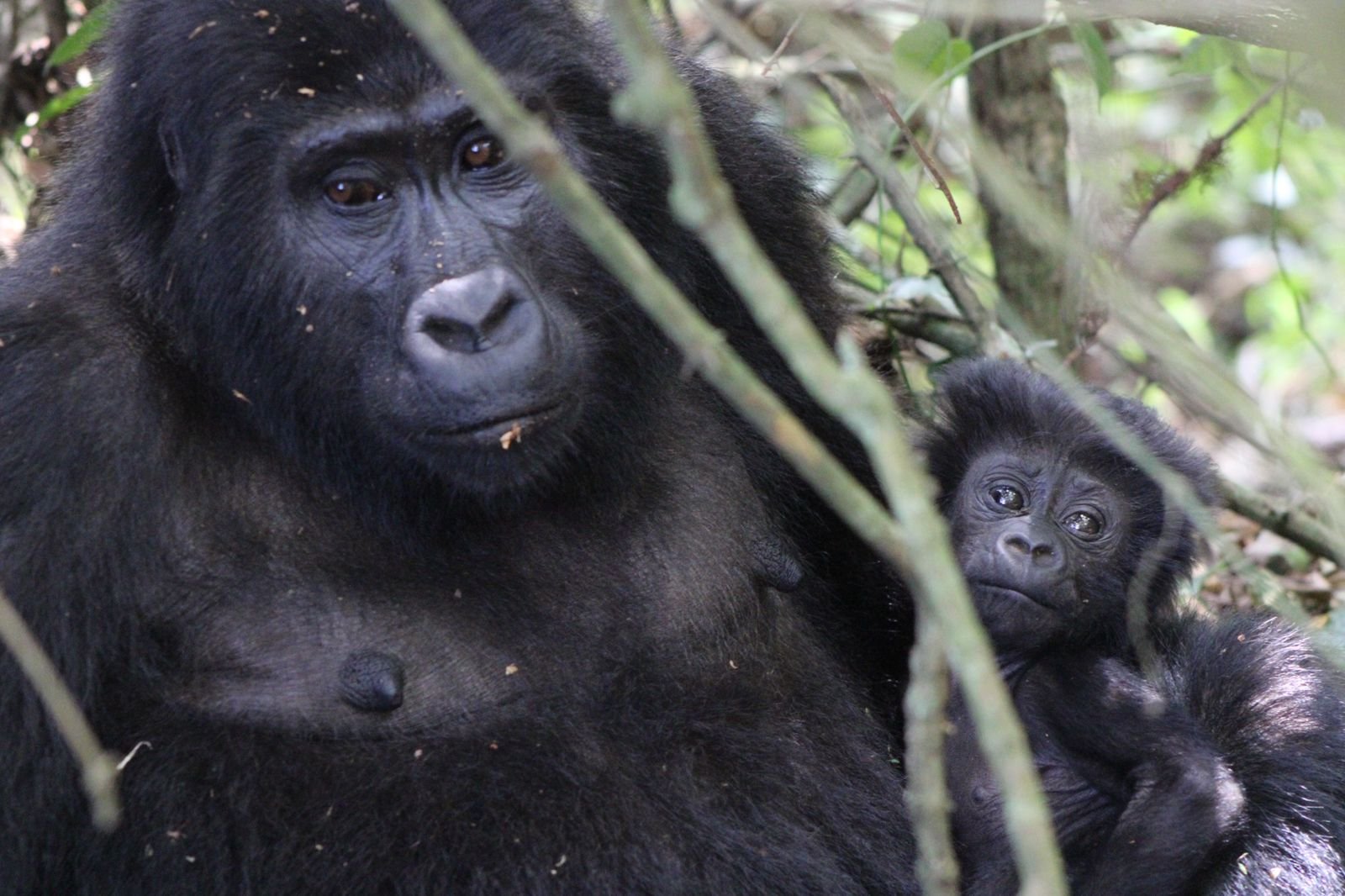
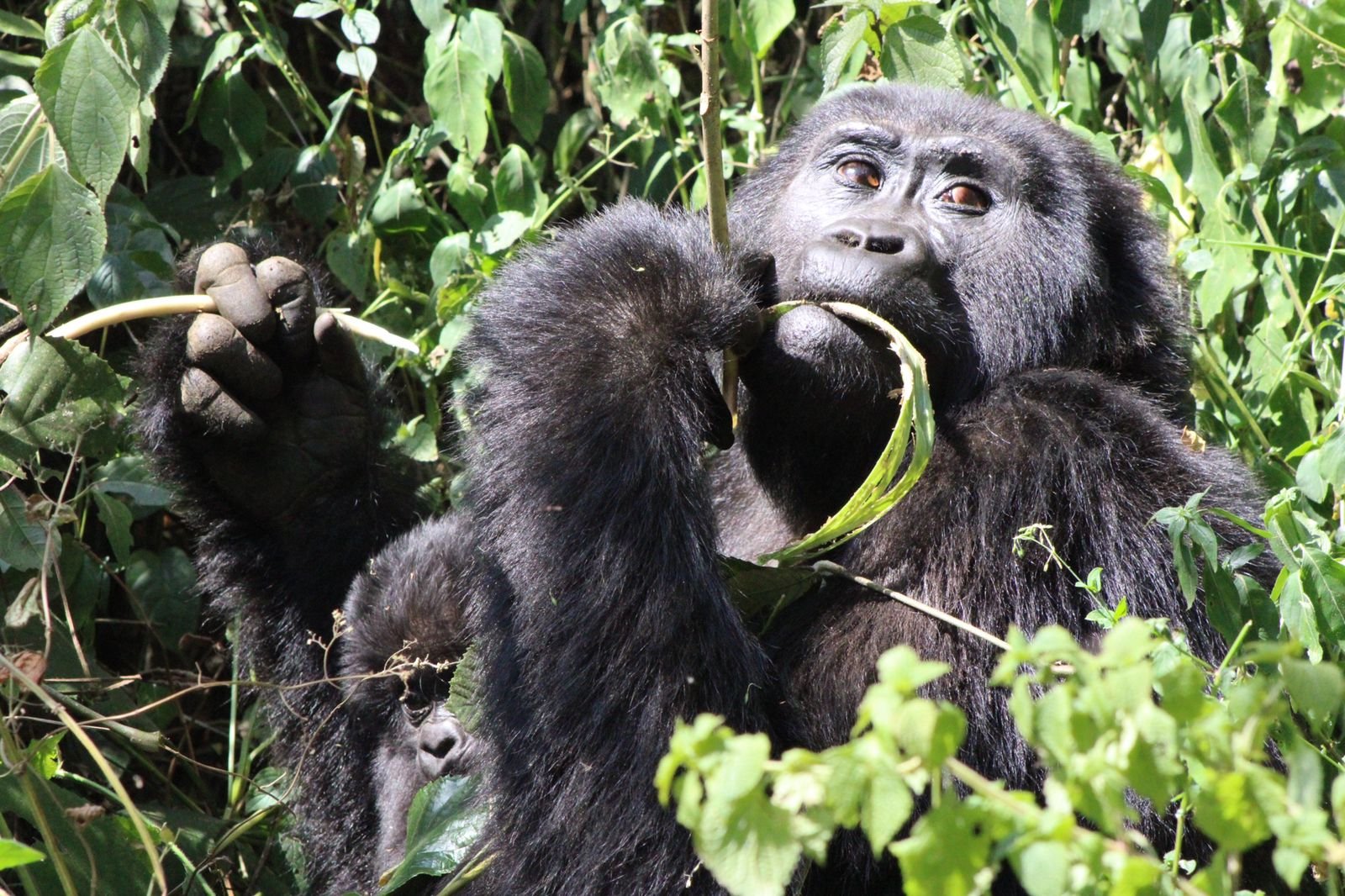
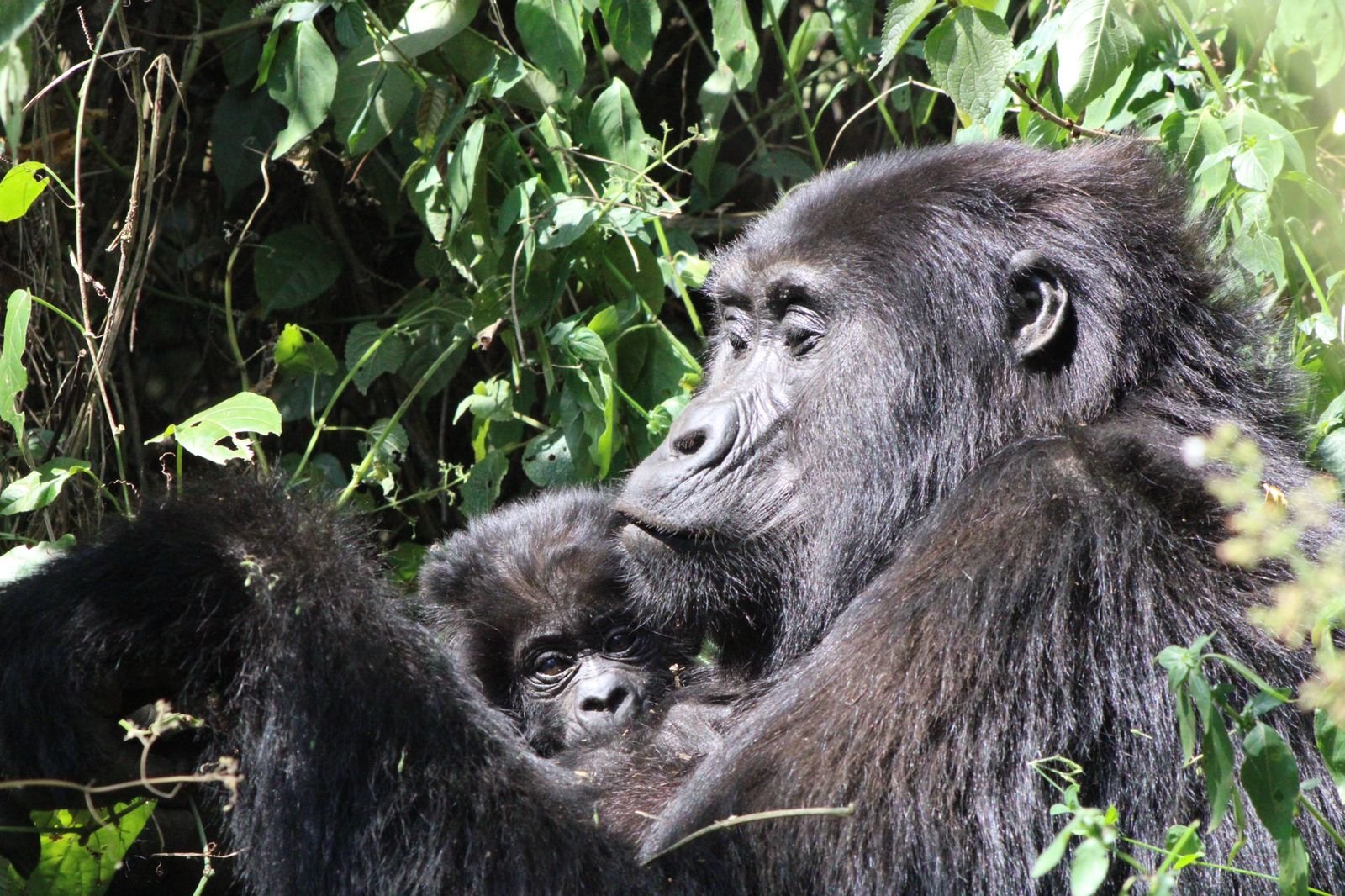
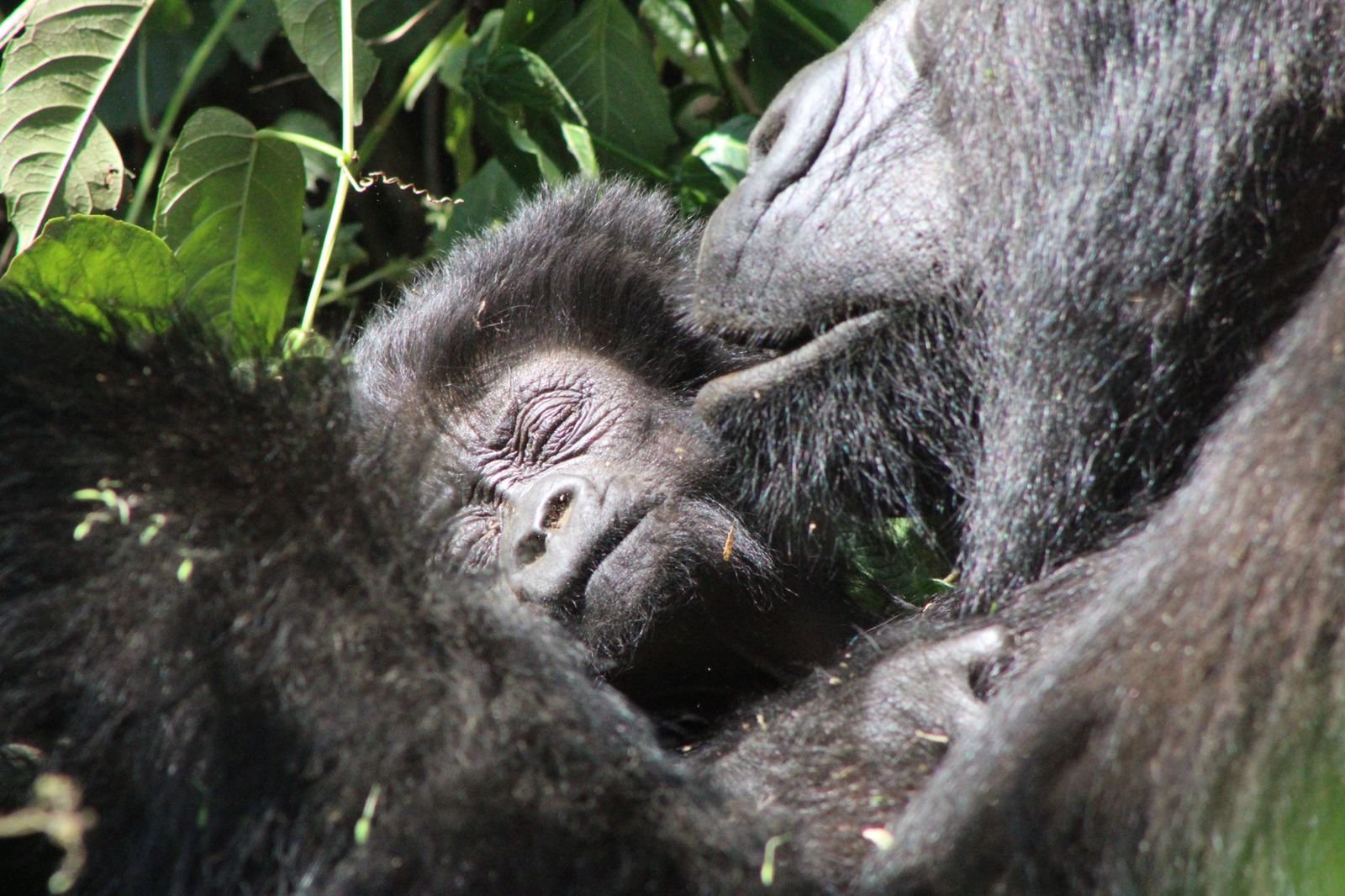
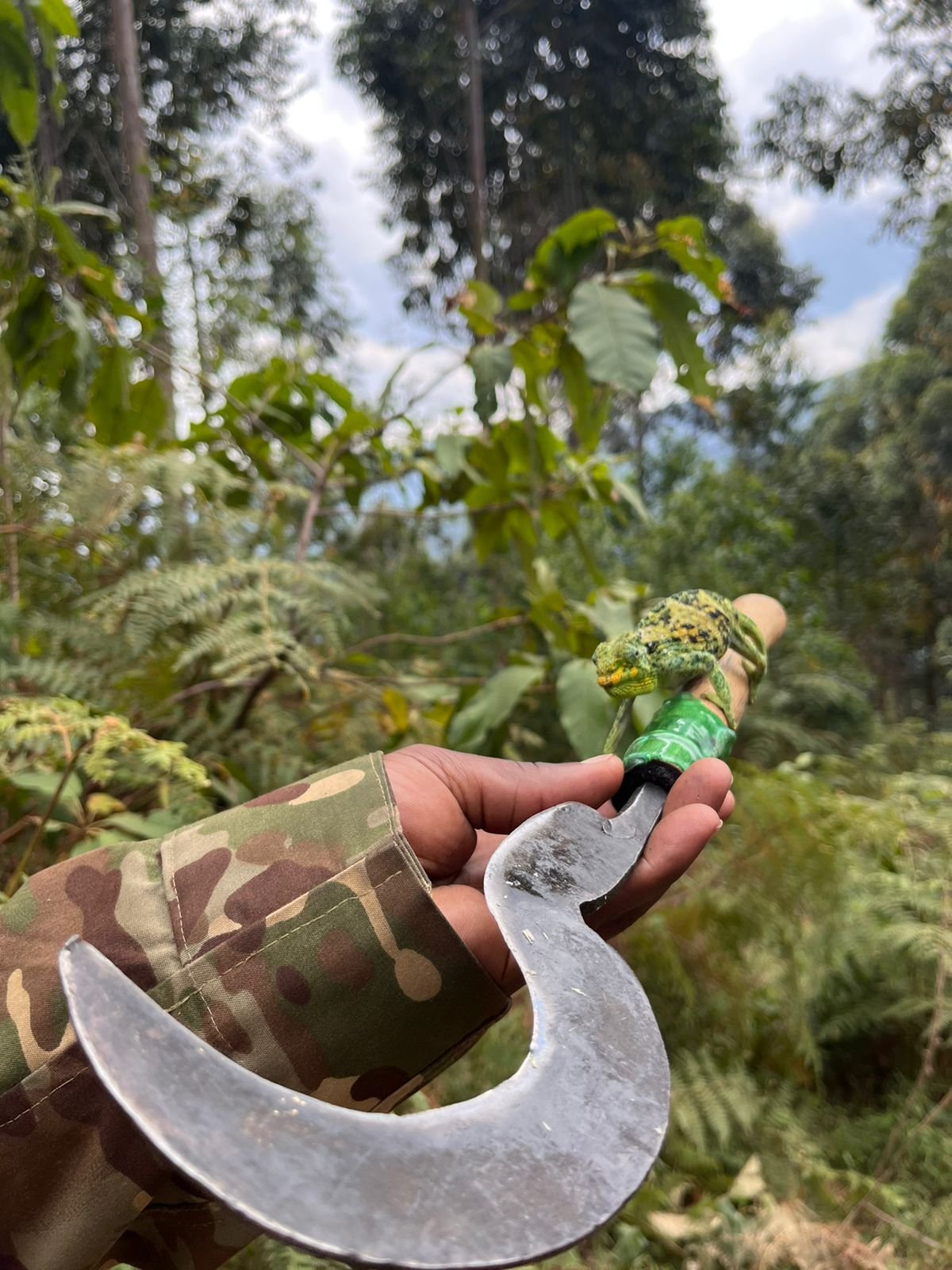
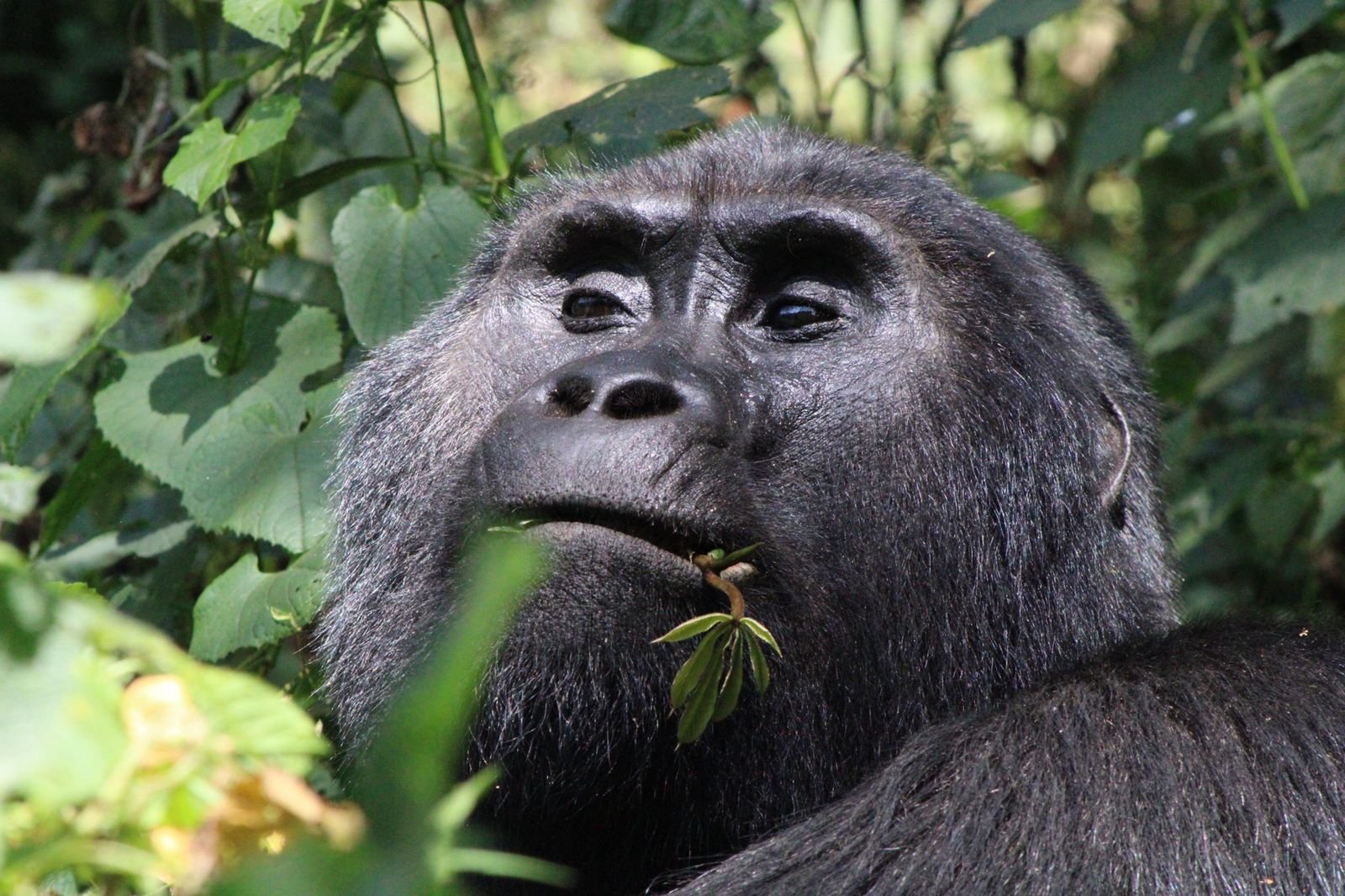
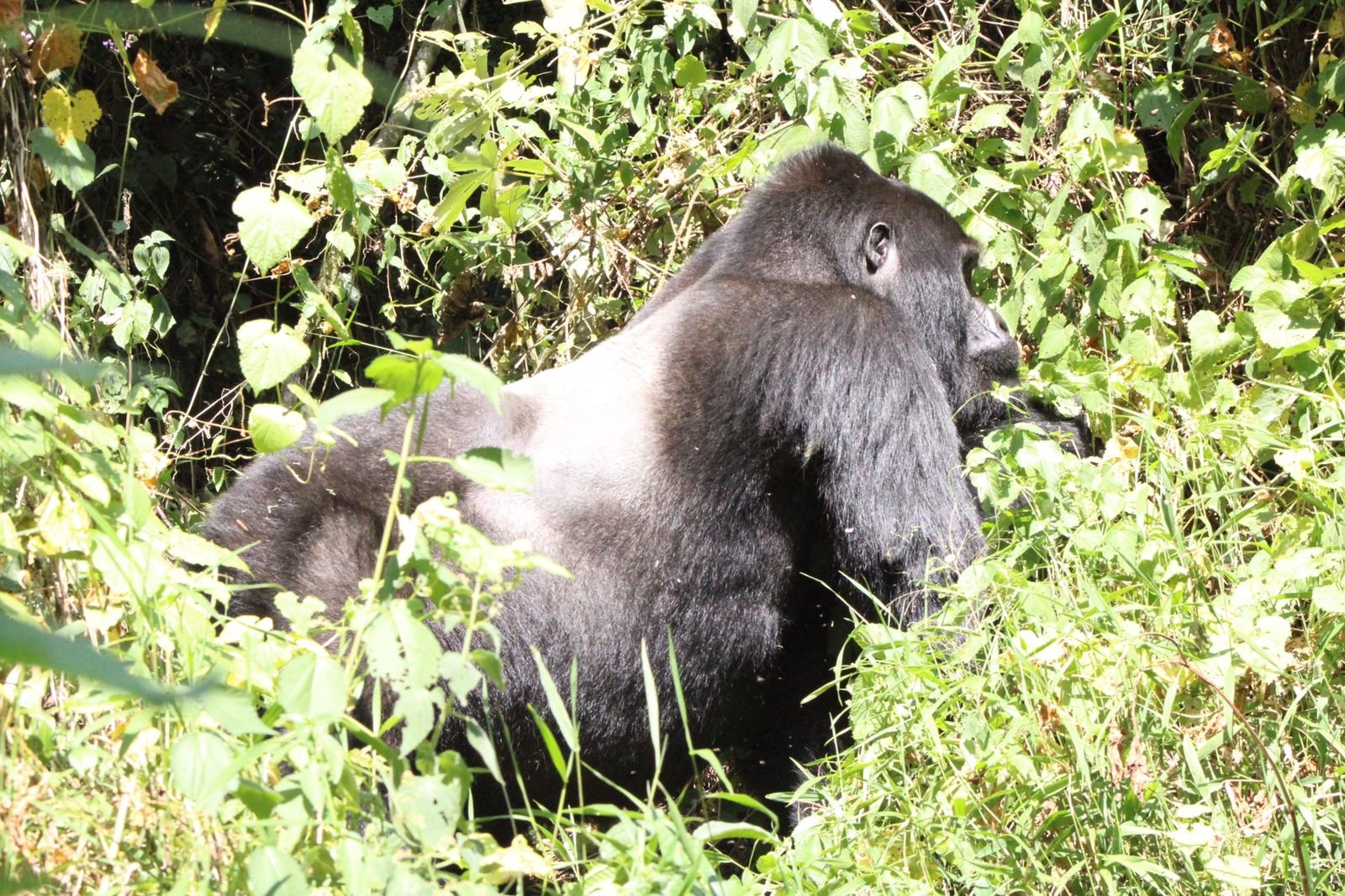
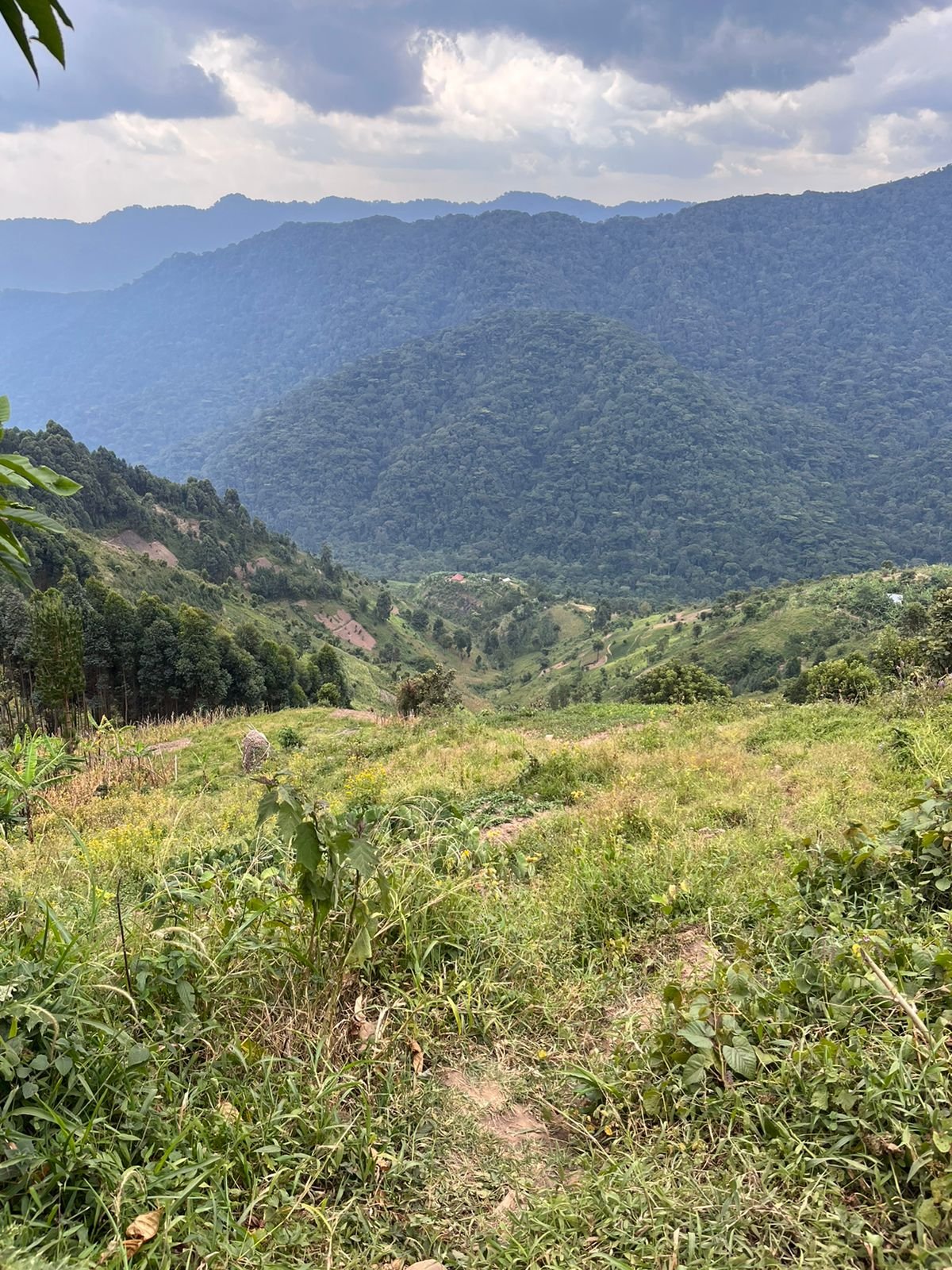
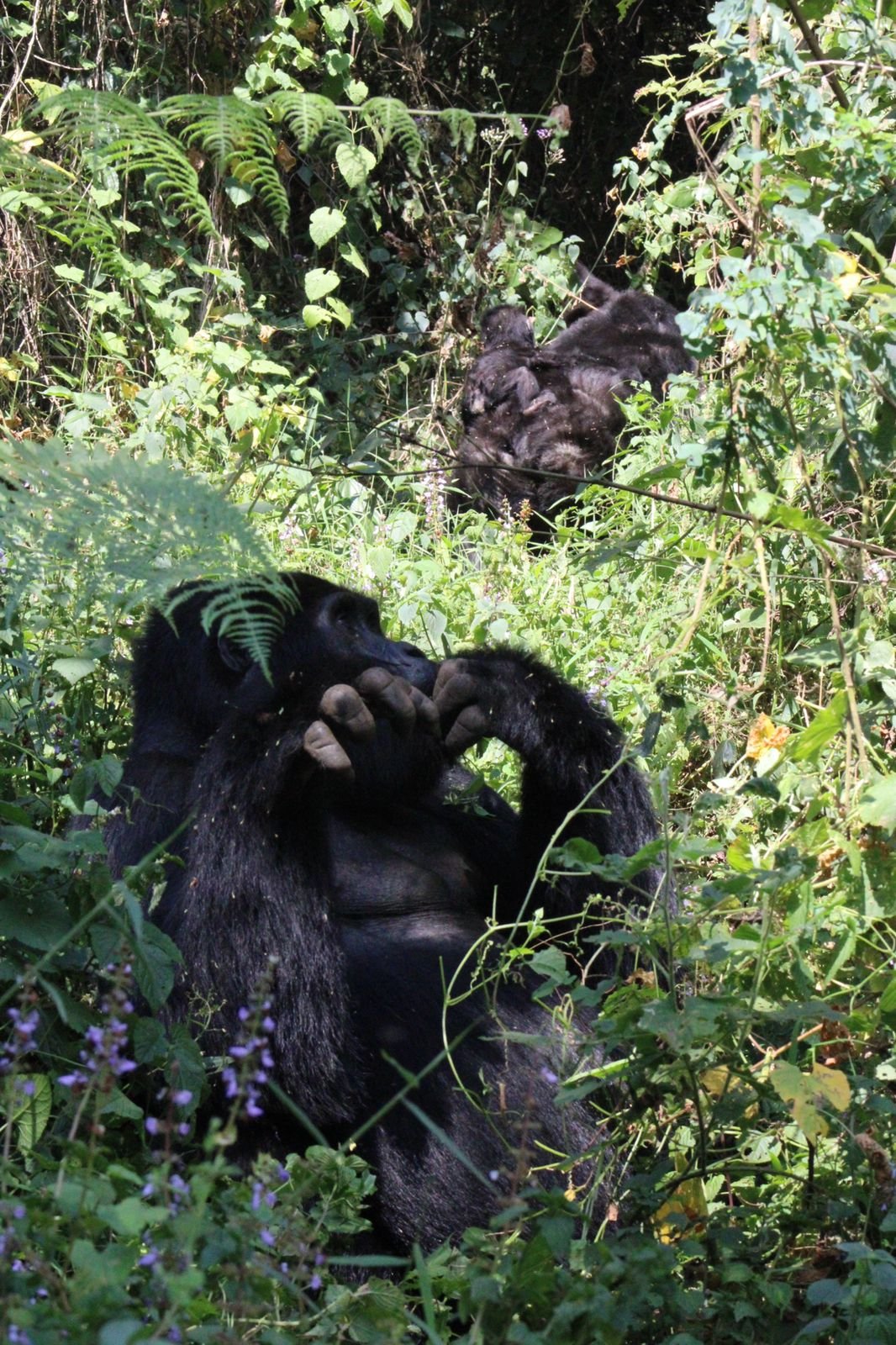
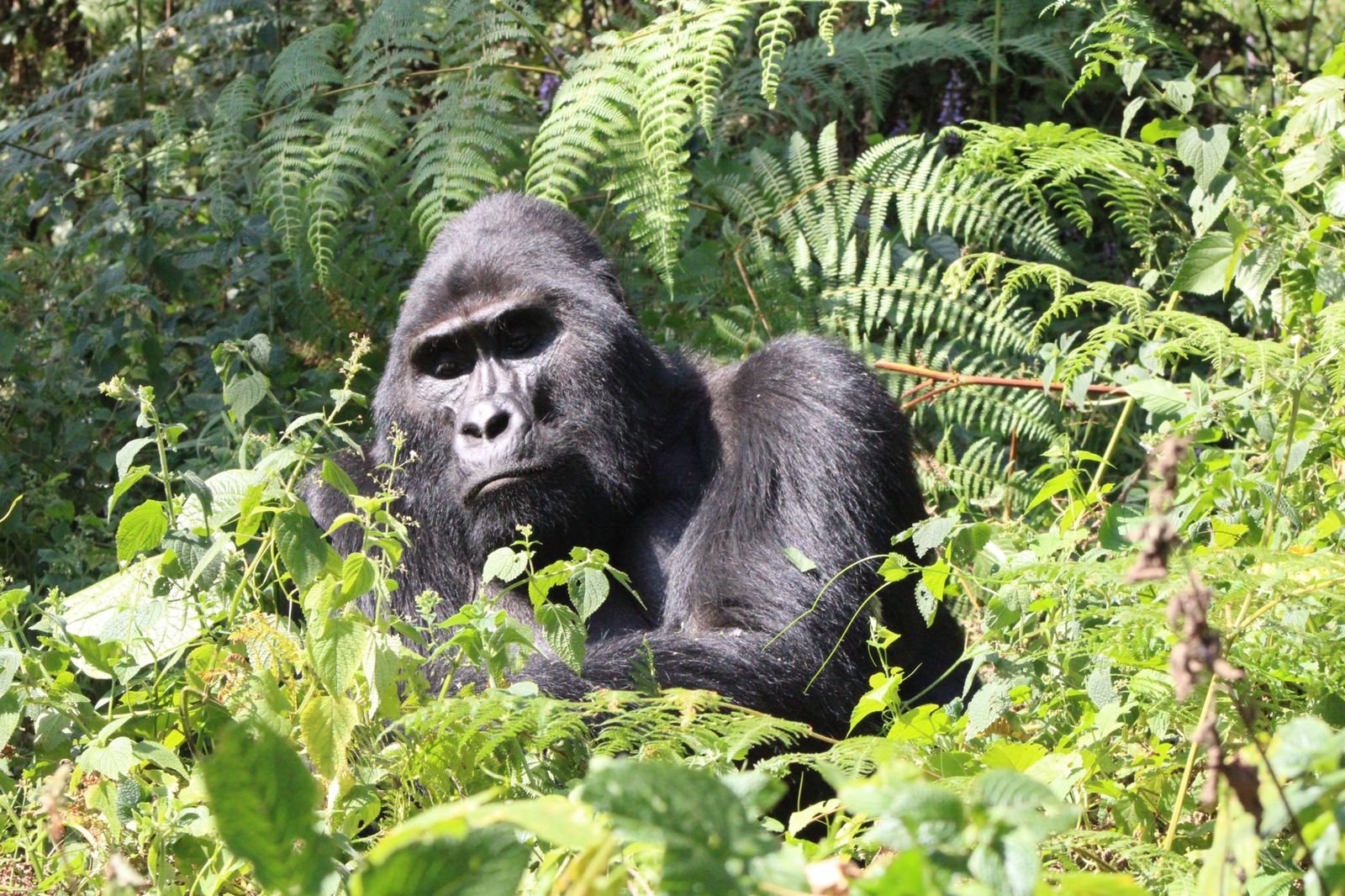
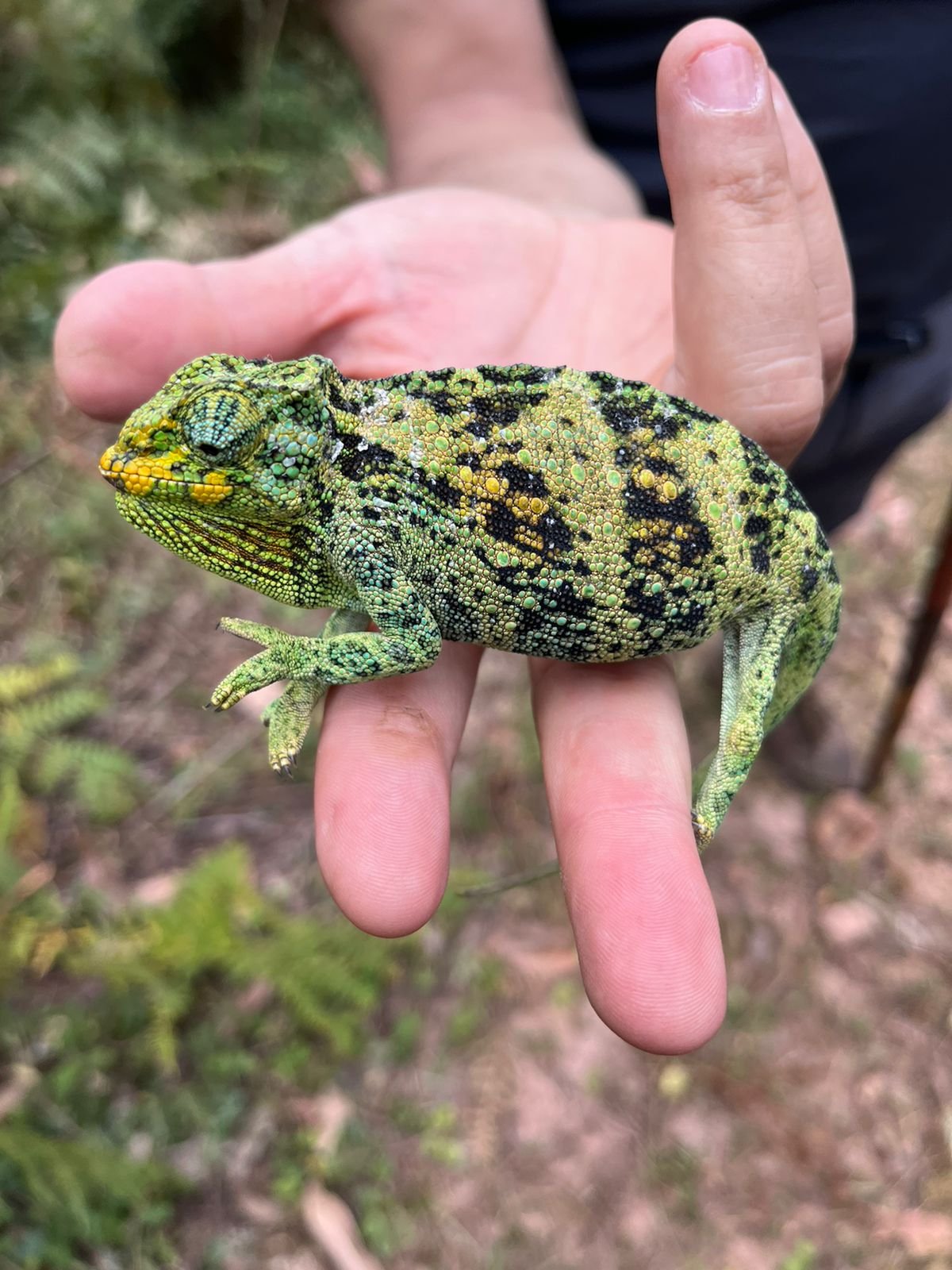
Since the silverback sets the tone, he let the rest of the family know that it was okay to come and show themselves. This is in addition to the rangers checking in with the gorillas through a series of moans and hand gestures. We were gestured to continue walking through the forest, only to be met by a female gorilla and her baby. Another gorilla appeared, this time it was the black back of the group. Everything was happening so quickly; it was exciting and overwhelming at the same time. We were all snapping away, while trying to be present and in the moment of the experience. It seemed like there were gorillas all around us. One started to climb a tree and the others were all headed to a central location, the hollow of a tree to catch some shade and lay around. Our ranger called out that we had five more minutes, before we would began our trek back to have lunch. The time went so quickly!
All of a sudden, we are directed to get down as a gorilla was passing by! “Get down, Get DOWN,” the rangers exclaimed! Then right in front of us all, walks an adolescent female gorilla. She looked at me as she walked by and as she passed Ana, she stopped briefly and then proceeded on the path to her family. We spent about three more minutes with the family and then it was time to head back.
By this time, the “African Helicopter,” had arrived. Papa was able to enjoy the gorillas with us, but his infinite wisdom understood something that some of us may have overlooked. The same glorious hills we had just trekked down, we would now have the pleasure of trekking up! He knew that he had given his all to get down the hills with his daughter and granddaughter and didn’t want to risk injury or extend our journey.
We all gathered around with curiosity to see what was going to see what was going to happen next. I am sure that you all are imaging a medical grade helicopter, with medical professionals gathered all around — that is not exactly what came to provide Papa with some reprieve.
Out of nowhere eight men appeared sporting grey uniforms and very serious faces, as you can see from the photographs. With them was a wicker bed with poles on each side for leverage for the men to lift, a mattress and pillow for the comfort of the rider. They placed the mattress and pillow in the bed and asked Papa to lie down, he very happily obliged. His daughter and granddaughter kept their cool as the men lifted Papa and the bed in the air and proceeded to carry Papa up the hill. I had to stop on more than a few occasions to catch my breath and those men trekked up the hill with Papa as if he were weightless, which was not the case. Luckily at the top of the hill, lunch was scheduled, and we could take a break. Y’all this was not a regular hill; it was a part of the tea plantation. So, on top of not being able to breathe, you are fighting with tea leaves the entire way and the incline was sent to earth from the pits of hell. You definitely get your monies worth trekking back, the gorillas are icing on the cake. After lunch, these men along with others (they would rotate out along the way), carried Papa for at least 2.5 hours as we trekked back to headquarters. See below footage of Papa being whisked away by the “African Helicopter.”
“African Helicopter” crew. Don’t they look delighted? LOL
After making it up the hill, we ate lunch and rested for about 30-45 minutes. The remainder of the trek provided us with lot of time to reflect about our experience. It was difficult, I am not going to lie to you! At one point during one of our many pitstops on the way back, Jeffery asked me if I needed an African Helicopter. With my hands on my hips completely out of breath, I waved him on and told him that I would make it! That is because I was trying to keep up with young Alice who was at the head of the pack!
As we were walking back, we saw villagers and locals tending to their daily activities, beautiful scenery and wildlife. In fact, we were able to spend some time with a pregnant chameleon, which I felt was an omen considering that I stayed at Chameleon Hills Lodge — read all about it here!
Pregnant Johnston’s chameleon
Below is the last video that I recorded before arriving at headquarters. I find it to be funny and wanted to share it because my first videos, were much more optimistic. Coming from Colorado and being exposed to higher elevations, I was cocky in my assumptions that this would be an easy task. And, while the altitude was not my greatest determent, those inclines and switchbacks are not for the weak! Also, it was hot — I would say around 80-85 degrees, both Ana and I had on significantly less, clothes our trek progressed!!! At one point I wanted to take my skin off… Little did I know — Africa can get much hotter but we’ll talk about that in a different blog coming next week….
Once back at camp, we were congratulated and given completion certificates from the Uganda Wildlife Authority. I exchanged information with some of my fellow trekkers to keep in touch and I am so happy that I did!! Huge shout out once again to Ana from Mexico - she is below in the white top with black shorts! She is responsible for all of the up-close shots of the gorillas that you see on my blog and social media! I am glad because due to her shots, I learned that I saw more gorillas than I originally thought— SUPER COOL! When I tell you she was about that action, baby girl did not come to play, a complete bad ass and she has been to Colorado for skiing! Hopefully, we will connect again soon!
I met up with my driver Andrew and he took me back to the lodge to shower and get some rest before dinner!
THE COSTS AND EQUIPMENT:
A gorilla permit is a document or card issued by ORTPN, Rwanda Development Board or Uganda Wildlife Authority that allows any traveler above 15 years of age, to trek mountain gorillas in any of the three habitats – Uganda, Rwanda and Democratic Republic of the Congo.
The gorilla permit includes two armed rangers for your jungle security and a knowledgeable tracking guide to lead you to where a mountain gorilla group that you will be visiting for the day.
After verifying your permit at any of the forest trailheads, your assigned guide will lead you and seven other trekkers into the forest, guarded by armed rangers for your security against wild animals and anything that would threaten your wellbeing.
Once you find the assigned gorilla family, your acquired gorilla trekking permit will allow you exactly one hour in their presence. However, the gorilla trekking activity can take approximately 30 minutes to 9 hours to find the assigned gorilla family. Nonetheless, most tourists usually find them in less than 3 hours. We trekked in total for about six hours.
The gorilla permit in Uganda costs USD $700 per person per day. The minimum age for a permit is 15 years old. A permit for foreign residents (with work permits) costs $600, and East African nationals pays 250,000 Ugandan francs per person.
A gorilla permit in Rwanda costs USD $1,500 per person per day. The minimum age for a permit is 15 years old. A permit for foreign residents (with work permits) costs $600, and East African nationals pays 20,000 Rwandan francs per person.
A gorilla permit in Congo for both lowland and mountain gorillas’ costs USD $400 per person per day. The minimum age for a permit is 15 years old. A permit for foreign residents (with work permits) costs $200, and East African nationals pays $200 per person.
List of 10 things to pack for your gorilla trekking trip:
For Coronavirus (Covid-19) prevention, carry two mask, hand sanitizer
Pack a decent waterproof jacket, A pair of gardening gloves
Long pants, long sleeved shirt and longer socks
Camera
Trekking boots are your best friend
Pack a tin of Insect repellent
Snacks/Lunch
Biodegradable tissue or toilet paper
Waterproof backpack and extra batteries
Trekking poles or hiking staffs
FINAL THOUGHTS:
All and all, gorilla trekking was a life altering experience for me. I am so glad that I was able to experience these wonderful creatures and will do my part to make sure that future generations are able to experience them as well. Habituation comes with risks — as the gorillas become more comfortable with human encounters, they are more likely to get killed or harmed by poachers. However, I must say that I am expressed with the approach of conservationist in Rwanda, Uganda and DRC and their dedication to growing and revitalizing gorilla populations. Not to mention because of political corruption and civil unrest, many people risk their lives DAILY to protect these animals. Knowing what I know now, I would pay the extra money for the habituation experience and spend 4 hours with a family. I am absolutely fascinated by these creatures. It is also a goal of mine to trek in all three locations Rwanda, Uganda and The Congo.
Next, I would like to go to the Congo and see the gorillas in Virunga National Park and Lake Kivu— the biggest freshwater lake in Rwanda and Congo. Virunga National Park’s headquarters at Rumangabo is home to the Senkwekwe Centre, the world’s only facility for orphaned mountain gorillas. With expert staff who provide daily care for the orphans, who were each separated from their family due to the impact of poaching, the Senkwekwe Centre is a unique sanctuary offering the gorillas the chance to lead happy and secure lives in their forested enclosed habitat.
Virunga National Park is the only protected area on Earth home to have three classifications of great apes: the mountain gorilla, eastern lowland gorilla and eastern chimpanzee. Park rangers and staff strive to provide conditions which support the growth of their populations, which are threatened by conflict, habitat loss and poaching, leaving them in danger of extinction.
Despite being a UNESCO world heritage site, Virunga is constantly threatened by war, poaching and illegal activities as well as unpreventable natural disasters. According to Virunga.org, “protecting wildlife and communities, Virunga’s ‘guardians of biodiversity’ risk their lives daily in the world’s most dangerous park for Rangers. Dozens of rebel groups operate in and around the park, sustained by illegal resource trafficking and poaching — a war economy that is worth an estimated 170 million dollars a year. In the past 20 years, over 200 rangers have made the ultimate sacrifice for conservation and security. Conflict in the turbulent region continues to be a concern, heavily impacting Virunga’s conservation efforts and growing green economy.
I know to some this may sound dangerous, yet I am committed to a sustainable planet and that means comprehensively understanding ecosystems. At some point, we must acknowledge that it cannot be one or the other when it comes to PEOPLE and the PLANET! We have to make the decision to choose both. I am leaning in deeper to make sure that I am doing my part to do both! Also, I finally feel like I am walking in purpose, these apes hold a key for me.
In the future, I hope more Black and African scientists are able to share their research, knowledge and stories of gorilla conservation and population growth. These are the men in women putting everything on the line, the world should hear directly from them regarding their communities and resource distribution. The people of Congo live on less than $5.00 a day, while a few around the world collect billions.
The global challenges are complex, and I am grateful for opportunities like these to see the world and the many solutions from another point of view.
I hope that you enjoyed this blog and that you learned something! Be on the lookout for all things Egypt next week!
With gratitude!
XOXO
Sallee Jay





